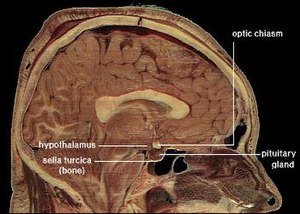Pituitary gland
The pituitary gland (or hypophysis) is an important part of the endocrine system. It is at the base of the brain between the eyes. The pituitary is attached to the hypothalamus, which is also a gland. The pituitary controls a whole range of vital functions by secreting hormones.


The pituitary gland consists of two parts: the anterior pituitary and the posterior pituitary. It is functionally linked to the hypothalamus by the pituitary stalk (also called the infundibulum).[1]
The hypothalamus releases factors down the pituitary stalk to the pituitary gland where they cause the release of pituitary hormones. Although the pituitary gland is known as the 'master' endocrine gland, both of the lobes are under the control of the hypothalamus.[2] Endocrine cells of the anterior pituitary are controlled by regulatory hormones released by neurosecretory cells in the hypothalamus.
Hormones released
changeThe gland releases several kinds of hormones.
Anterior pituitary
changeThe endocrine cells of the anterior pituitary are controlled by neurosecretion from the hypothalamus. The anterior pituitary cells synthesizes and secretes these important endocrine hormones:
- Adrenocorticotropic hormone (ACTH): released under conditions of stress. Increases corticosteroids.
- Thyroid-stimulating hormone (TSH): regulates thyroid gland.
- Growth hormone ('HGH'): stimulates cell division and growth.
- Prolactin (PRL): stimulates milk production in breasts.
The two gonadotropins;
- Luteinizing hormone (LH): in females, it triggers ovulation. In males it stimulates testosterone (acts with next).
- Follicle-stimulating hormone (FSH): regulates development, growth, puberty, reproduction.
- Intermediate lobe
Here one hormone is produced:
- Melanocyte-stimulating hormone (MSH): stimulates the production and release of melanin by melanocytes in skin and hair. MSH signals to the brain have effects on appetite and sexual arousal.
Posterior pituitary
changeThe posterior pituitary is actually an extension of the hypothalamus. Neurosecretory cells in the hypothalamus have axons that go right down into the posterior pituitary.[3] The posterior pituitary stores and secretes the hormones produced by these neurosecretory cells:
- Oxytocin, most of which is released from the hypothalamus: has effects on nerve transmission, and on females during and after birth. Has a role in pair-bonding, mating and maternal behaviour. Functions not yet entirely understood.
- Antidiuretic hormone (ADH, also known as vasopressin): controls the reabsorption of molecules in the tubules of the kidneys. Increases arterial blood pressure. It plays a key role in homeostasis, and the regulation of water, glucose, and salts in the blood.
Oxytocin is one of the few hormones to create a positive feedback loop. For example, uterine contractions stimulate the release of oxytocin from the posterior pituitary, which, in turn, increases uterine contractions. This positive feedback loop continues throughout birth labour.
References
change- ↑ "Median eminence - Glossary of Biochemistry and Molecular Biology". Archived from the original on 2011-07-11. Retrieved 2011-06-27.
- ↑ Dasen, J. S.; Rosenfeld, M. G. (1 December 1999). "Signaling mechanisms in pituitary morphogenesis and cell fate determination". Current Opinion in Cell Biology. 11 (6): 669–677. doi:10.1016/s0955-0674(99)00034-4. PMID 10600709 – via PubMed.
- ↑ Boron, Walter F. & Boulpaep, Emile L. 2009. Medical physiology. 2nd ed, Philadelphia: Saunders Elsevier. pp. 1016–1017. ISBN 978-1-4160-3115-4
| Endocrine system |
| Adrenal gland - Corpus luteum - Hypothalamus - Ovaries - Pancreas - Parathyroid gland - Pineal gland - Pituitary gland - Testes - Thyroid gland - Hormone |